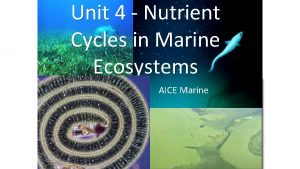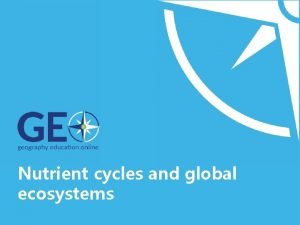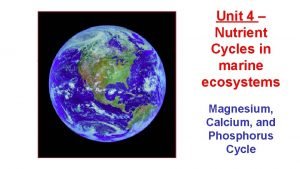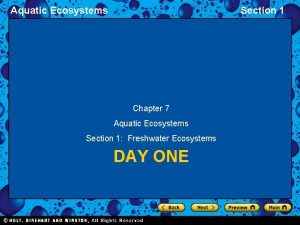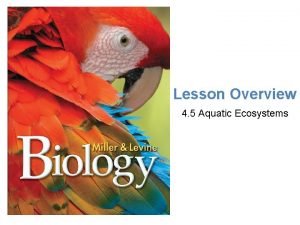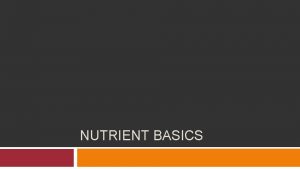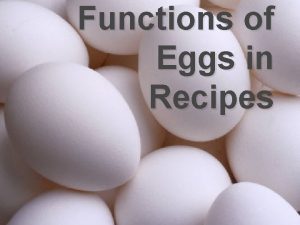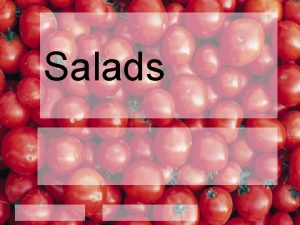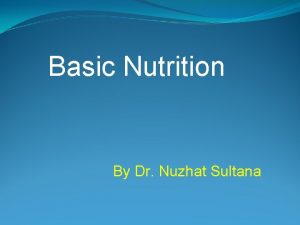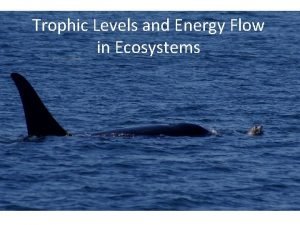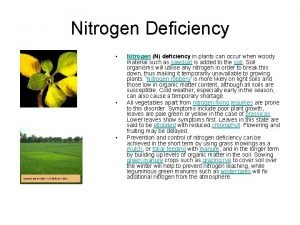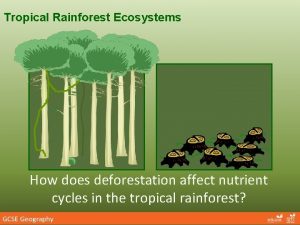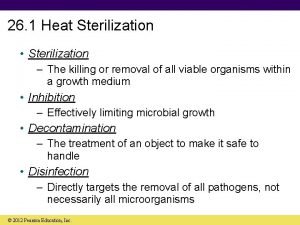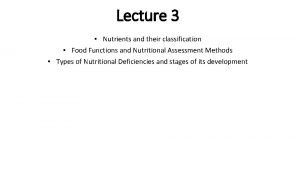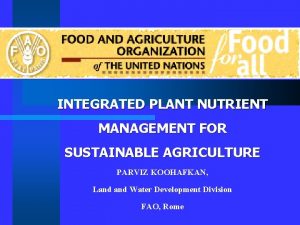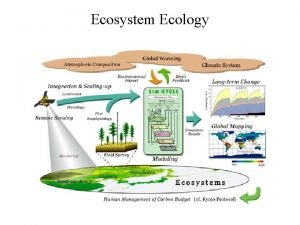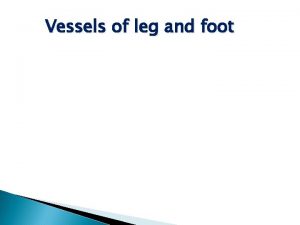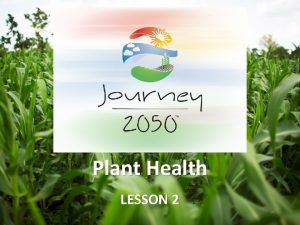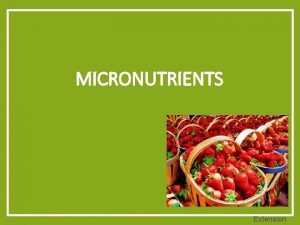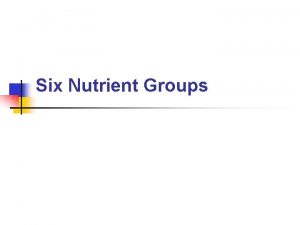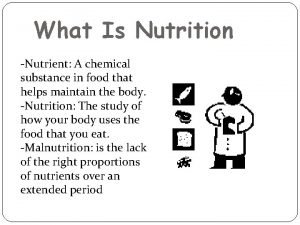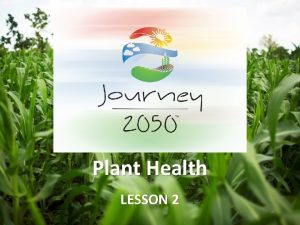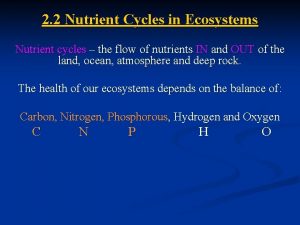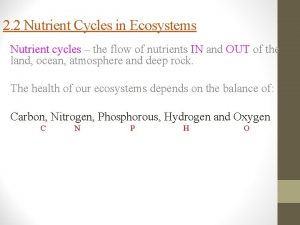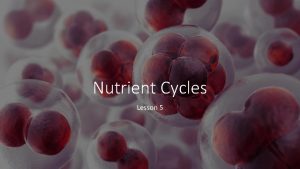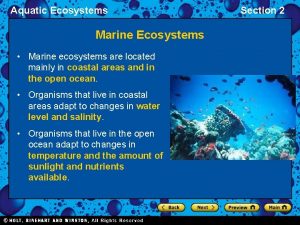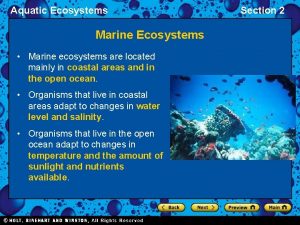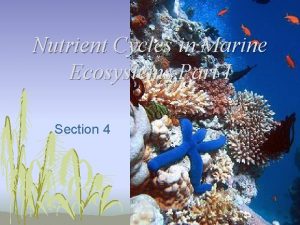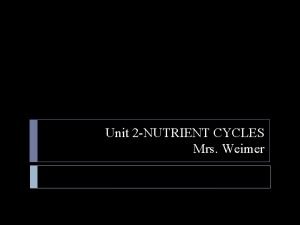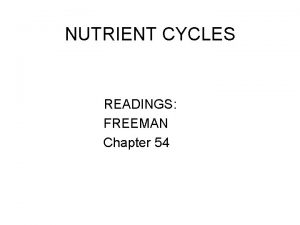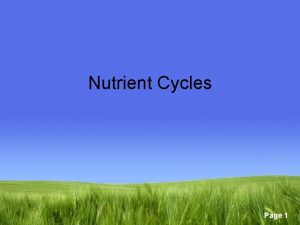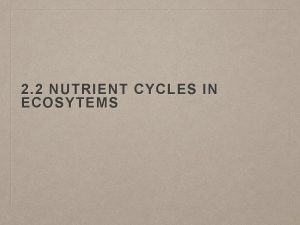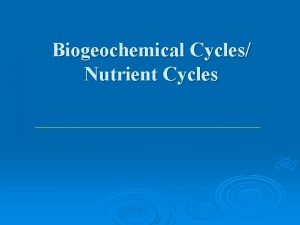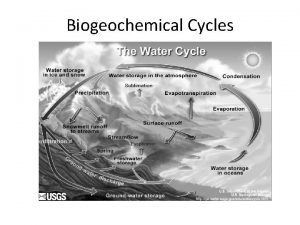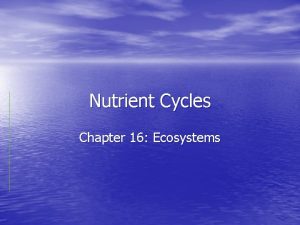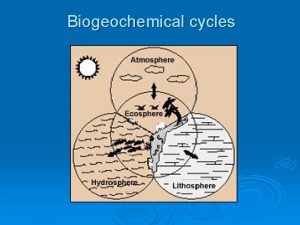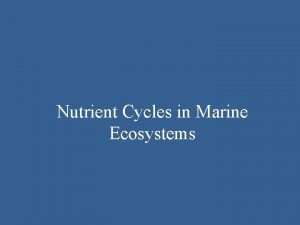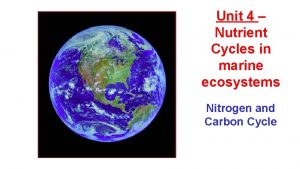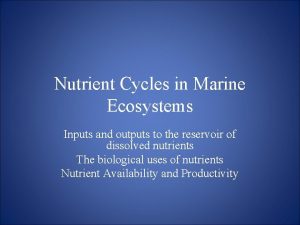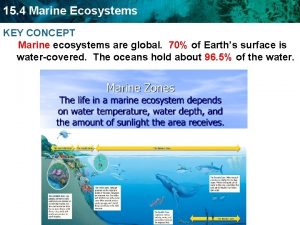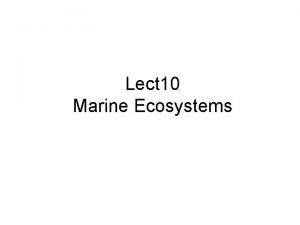Nutrient Cycles in Marine Ecosystems Part 2 Surface

























- Slides: 25

Nutrient Cycles in Marine Ecosystems – Part 2

Surface Layer of Ocean • Dissolved nutrients • Recall: algae require light for photosynthesis • Intensity of light as depth • Restricted to surface layer (photic zone) • Depth 30 m to 150 m • Obviously less in turbid water (high turbidity)

What is an ion? • atom or molecule in which the total number of electrons is not equal to the total number of protons, giving the atom a net positive (+) or negative (-) electrical charge.

SOME Surface Layer Ions 1. Copy this table. 2. Create a bar graph from the information above

Surface Ions • Those ions, together with nitrate and phosphate ions form nutrients for growth of algae and other producers • Nitrate and phosphate ions occur in low concentrations in seawater • Nitrate = 0. 5 ppm • Phosphate = 0. 07 ppm

Replenishment of dissolved nutrients (3) • 1. Upwelling – movement of water from deep in the ocean to the surface layer, where nutrients become available to primary producers

Causes of Upwelling • Deflection of deep water currents upwards • Nutrients sunk to sea floor brought back up to surface of ocean • Movement of water away from the coast by wind

2. Run-off from land • Part of hydrological cycle • Water leach nutrients (including nitrates and phosphates) from soil

3. Atmospheric Gases • CO 2 dissolved in seawater forming hydrogencarbonate ions (HCO 3 -) • AKA bicarbonate • Makes CO 2 available for fixation in photosynthesis for primary producers • N gas is fixed by blue-green algae in intertidal zones • Forms nitrogen-containing organic compounds • How nitrogen enters marine ecosystems

Intertidal Zone Area above water during low tide but underwater during high tide

Nitrogen Cycle

Recycled • Nutrients like nitrates and phosphates are recycled at the ocean surface by excretion from zooplankton

Depletion of dissolved nutrients • Uptake by primary producers like phytoplankton • Synthesis of organic substances • Example: nitrate ions used for synthesis of amino acids and proteins • Phytoplankton zooplankton small fish • Proteins passed to next trophic level and so forth


Recall

Limited Productivity • Inorganic nutrients (ex: nitrate and phosphate ions) are essential for growth of primary producers • Productivity of primary producers will affect productivity of higher trophic levels Example: upwelling – high productivity

Benguela upwelling system

Removal of Nutrients 1. Sink to sea floor • • In feces Detritus (decaying organic materials); organisms die Loss of nutrients from surface water • • • Will only return to surface by upwelling Slow decomposition on sea bed (floor) due to cold/lack of oxygen


Removal of Nutrients 2. Incorporated into coral reefs • Deposition of calcium carbonate for growth of corals

Removal of Nutrients 3. Removed by harvesting • Removing/eating fish and other marine organisms


Nutrient Biological Uses Nutrient Biological Use Nitrogen Make proteins; synthesis of amino acids Carbon Synthesis of all organic materials (ex: carbohydrates, proteins) Magnesium Make chlorophyll for plants Calcium Production of bones, corals and shells Phosphorus Production of bones and synthesis of DNA

Nutrients derived from both Removal (3) • Summary of ways in nutrients are cycled in marine systems

In Summary • Fertilizers, like nitrogen (N), phosphorous (P), and potassium (K), are important for plant growth and are called 'nutrients. ' The level of dissolved nutrients increases from animal feces and decomposition (bacteria, fungi). Surface water often may be lacking in nutrients because feces and dead matter tend to settle to the bottom of the ocean. Most decomposition is thus at the bottom of the ocean. In the oceans most surface water is separated from bottom water by a thermocline (seasonal in temperature and marginal polar regions, constant in tropics) which means that once surface nutrients get used up (by the plants there) they become a limiting factor for the growth of new plants. Plants must be at the surface for the light. Nutrients are returned to surface waters by a special type of current called 'upwelling' and it is in these areas of upwelling that we find the highest productivity of marine life.
 A terrestrial food web
A terrestrial food web Venkatraman ramakrishnan medium composition
Venkatraman ramakrishnan medium composition Apes cycles
Apes cycles Nutrients cycle
Nutrients cycle Biological use of magnesium in marine ecosystems
Biological use of magnesium in marine ecosystems What two locations are marine ecosystems usually located
What two locations are marine ecosystems usually located How do ecologists usually classify marine ecosystems?
How do ecologists usually classify marine ecosystems? Nutrient basics
Nutrient basics Structure agent in eggs
Structure agent in eggs Four types of salad
Four types of salad Dr nuzhat sultana
Dr nuzhat sultana Energy in trophic levels
Energy in trophic levels Regents biology food chains and energy in ecosystems
Regents biology food chains and energy in ecosystems Nutrient deficiency in tomatoes
Nutrient deficiency in tomatoes How does deforestation affect the nutrient cycle
How does deforestation affect the nutrient cycle Nutrient agar plate
Nutrient agar plate What are the classification of nutrients
What are the classification of nutrients Integrated plant nutrient system
Integrated plant nutrient system Nutrient cycle in the serengeti
Nutrient cycle in the serengeti Lateral malleolar artery
Lateral malleolar artery Which nutrient practice was best journey 2050
Which nutrient practice was best journey 2050 Nutrient interactions
Nutrient interactions Six nutrient groups
Six nutrient groups Chemical substance in food that helps maintain the body
Chemical substance in food that helps maintain the body Journey 2050 student handout 2 word search
Journey 2050 student handout 2 word search Gersmehl model deciduous woodland
Gersmehl model deciduous woodland
